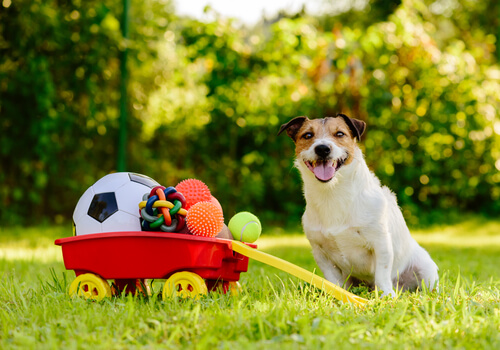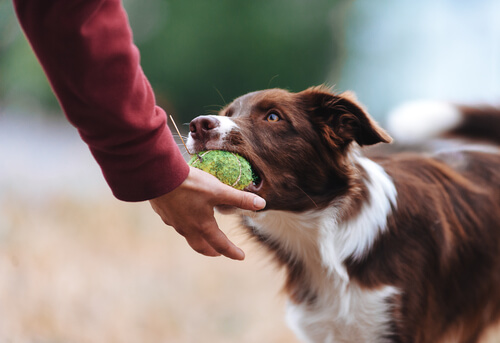I Have a Possessive Dog: What Can I Do?


Written and verified by the biologist Georgelin Espinoza Medina
Pets are adorable creatures that bring us much joy and great company. However, things are not always perfect, and, in certain circumstances, they may have unwanted behavior which we must learn to manage. So what should we do if we have a possessive dog?
Possessiveness is a type of aggressive behavior manifested by dogs. If you have a dog with this behavior problem, then this article is for you, as we’ll bring you all the details related to the problem and give you the guidelines you should follow in this regard, do not miss it.
Aggression due to possessiveness and protection

There are different types of aggressive behavior in dogs, and one of them is aggression due to possessiveness. This refers to all defensive behavior by a dog towards anything that they deem to be theirs and which is valuable to them. This behavior could be directed towards humans or any other animal (not necessarily another dog).
It’s common that the terms possession aggression and resource protection to be used interchangeably. However, for some specialists, the term protection is broader and includes behavior such as body blocking, keeping guard, or running off with the item in question. On the other hand, other experts say that possession aggression is the most severe form of these behavior patterns.
What’s a possessive dog like?
The dog can be possessive with various items, for example, with its food, a bone, a toy, its bed, and also very overprotective of its owner. The dog can growl, bare its teeth, snap, and bite when someone approaches that object or person and they think they want to take it. They can also behave in a hostile manner towards strangers who approach their master.
The diagnosis isn’t so simple, and it requires the description of the behavior, the specification of stimuli, as well as the dog’s medical history. In many cases, for an accurate analysis, it’s necessary to observe or simulate the problem in the pet’s natural environment, i.e. at home. It may also be necessary to perform some tests to rule out any health problems (such as pain).
Aggression behaviors are varied, ranging from barking and growling, to biting and attacking.
The development of this type of behavior may be due to an alteration of the hierarchy of the dog and owner, creating problematic and dangerous behavior. Especially where there are children concerned.
Possessive dog breeds
Any dog, regardless of its size or breed, can be possessive. However, it’s true that there’s a genetic predisposition for some types of dogs. Thus, this behavior is more frequent in the following:
- Cocker Spaniels
- Border Collies
- Rottweilers
- Jack Russells
- Golden Retrievers
In a study conducted in the New York Metropolitan Area, 245 cases of behavioral problems in dogs kept as companion animals were evaluated, in which 65 had possession aggression. Of these, 43 were males, 34 were intact and 9 were neutered. On the other hand, only 22 females, 2 intact and 20 spayed. In addition, most of them were cocker spaniels.
However, this doesn’t mean that all dogs of these breeds have these behavioral problems, as, apart from DNA, there are other factors that influence behavior, a very important one being breeding.
In addition, there’s individual variation in dog behavior. Some show an aggressive response with little stimulation, while, in others, it’s the opposite and they never try to bite.
How should you correct a possessive dog?
The first thing to keep in mind is that cases of aggression cannot be solved by punishing the animal, since this attitude encourages violent behavior. Here are some general recommendations on what to do when faced with a possessive dog:
- Try to work on basic obedience in the dog in all scenarios, which includes teaching them to follow commands (come, sit or eat). These exercises help them visualize you as their leader.
- Other options include feeding him using your hand, in different places, which also helps to reaffirm your position of dominance over them.
- Likewise, you shouldn’t let your dog sleep on your bed, or on top of you or any member of your family, as this practice is a form of domination for dogs. It’s advisable for them to have their own space and bed.
- If the dog shows possessive behavior towards toys or other objects, you should teach him to let them go and give them to you when you ask him to. In the beginning, this will be rather difficult, and you can start by exchanging the object for a treat of their liking.
- It’s also advisable to practice obedience, starting with exposure to things that aren’t so important for them, and progressing little by little until you precious for thedeal with the things that dogs consider most precious to them and which they exhibit possessive behavior with.
Consult an expert

Controlling a possessive dog requires a lot of care and patience, and the intervention of a canine behavior specialist may even be necessary. Therefore, talk to your veterinarian to establish a work program for you and your pet or, if necessary, refer them to an ethologist.
The prognosis can be variable, some improve significantly and quickly, while others require more time (weeks or months). Don’t be discouraged and always follow the instructions given to achieve satisfactory results.
Pets are adorable creatures that bring us much joy and great company. However, things are not always perfect, and, in certain circumstances, they may have unwanted behavior which we must learn to manage. So what should we do if we have a possessive dog?
Possessiveness is a type of aggressive behavior manifested by dogs. If you have a dog with this behavior problem, then this article is for you, as we’ll bring you all the details related to the problem and give you the guidelines you should follow in this regard, do not miss it.
Aggression due to possessiveness and protection

There are different types of aggressive behavior in dogs, and one of them is aggression due to possessiveness. This refers to all defensive behavior by a dog towards anything that they deem to be theirs and which is valuable to them. This behavior could be directed towards humans or any other animal (not necessarily another dog).
It’s common that the terms possession aggression and resource protection to be used interchangeably. However, for some specialists, the term protection is broader and includes behavior such as body blocking, keeping guard, or running off with the item in question. On the other hand, other experts say that possession aggression is the most severe form of these behavior patterns.
What’s a possessive dog like?
The dog can be possessive with various items, for example, with its food, a bone, a toy, its bed, and also very overprotective of its owner. The dog can growl, bare its teeth, snap, and bite when someone approaches that object or person and they think they want to take it. They can also behave in a hostile manner towards strangers who approach their master.
The diagnosis isn’t so simple, and it requires the description of the behavior, the specification of stimuli, as well as the dog’s medical history. In many cases, for an accurate analysis, it’s necessary to observe or simulate the problem in the pet’s natural environment, i.e. at home. It may also be necessary to perform some tests to rule out any health problems (such as pain).
Aggression behaviors are varied, ranging from barking and growling, to biting and attacking.
The development of this type of behavior may be due to an alteration of the hierarchy of the dog and owner, creating problematic and dangerous behavior. Especially where there are children concerned.
Possessive dog breeds
Any dog, regardless of its size or breed, can be possessive. However, it’s true that there’s a genetic predisposition for some types of dogs. Thus, this behavior is more frequent in the following:
- Cocker Spaniels
- Border Collies
- Rottweilers
- Jack Russells
- Golden Retrievers
In a study conducted in the New York Metropolitan Area, 245 cases of behavioral problems in dogs kept as companion animals were evaluated, in which 65 had possession aggression. Of these, 43 were males, 34 were intact and 9 were neutered. On the other hand, only 22 females, 2 intact and 20 spayed. In addition, most of them were cocker spaniels.
However, this doesn’t mean that all dogs of these breeds have these behavioral problems, as, apart from DNA, there are other factors that influence behavior, a very important one being breeding.
In addition, there’s individual variation in dog behavior. Some show an aggressive response with little stimulation, while, in others, it’s the opposite and they never try to bite.
How should you correct a possessive dog?
The first thing to keep in mind is that cases of aggression cannot be solved by punishing the animal, since this attitude encourages violent behavior. Here are some general recommendations on what to do when faced with a possessive dog:
- Try to work on basic obedience in the dog in all scenarios, which includes teaching them to follow commands (come, sit or eat). These exercises help them visualize you as their leader.
- Other options include feeding him using your hand, in different places, which also helps to reaffirm your position of dominance over them.
- Likewise, you shouldn’t let your dog sleep on your bed, or on top of you or any member of your family, as this practice is a form of domination for dogs. It’s advisable for them to have their own space and bed.
- If the dog shows possessive behavior towards toys or other objects, you should teach him to let them go and give them to you when you ask him to. In the beginning, this will be rather difficult, and you can start by exchanging the object for a treat of their liking.
- It’s also advisable to practice obedience, starting with exposure to things that aren’t so important for them, and progressing little by little until you precious for thedeal with the things that dogs consider most precious to them and which they exhibit possessive behavior with.
Consult an expert

Controlling a possessive dog requires a lot of care and patience, and the intervention of a canine behavior specialist may even be necessary. Therefore, talk to your veterinarian to establish a work program for you and your pet or, if necessary, refer them to an ethologist.
The prognosis can be variable, some improve significantly and quickly, while others require more time (weeks or months). Don’t be discouraged and always follow the instructions given to achieve satisfactory results.
All cited sources were thoroughly reviewed by our team to ensure their quality, reliability, currency, and validity. The bibliography of this article was considered reliable and of academic or scientific accuracy.
- Brochelt, P. (1983). Aggressive behavior of dogs kept as companion animals: classification and influence of sex, reproductive status and breed. Applied Animal Ethology, 10, 45-61.
- Jacobs, J., Coe, J., Widowski, T., Pearl, D., Niel, L. (2018). Defining and clarifying the terms canine possessive aggression and resource guarding: a study of expert opinion. Frontiers in Veterinary Science, 5,115.
- Morgan, R. (2011). Possessive and territorial aggression in dogs. Recuperado el 09 de octubre de 2022, disponible en: https://www.saintfrancis.org/wp-content/uploads/Possessive-and-Territorial-Aggression-in-Dogs.pdf
- Vega, C. (2004). Estudio clínico prospectivo de las principales anormalidades de la conducta de perros en el hospital de la Facultad de Medicina Veterinaria y Zootecnia (FMVZ) de la Universidad San Carlos de Guatemala y una clínica veterinaria privada. [Tesis de grado, Universidad de San Carlos de Guatemala]. http://www.repositorio.usac.edu.gt/7383/1/Tesis%20Med%20Vet%20Claudia%20Vega%20Ruiz.pdf
This text is provided for informational purposes only and does not replace consultation with a professional. If in doubt, consult your specialist.








